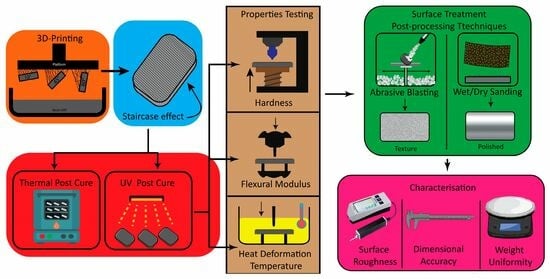Post-Process Considerations for Photopolymer 3D-Printed Injection Moulded Insert Tooling Applications
Abstract
1. Introduction
2. Materials and Methods
2.1. Fabrication of Plaques
2.2. Surface Finish Benchmarks
2.3. Post-Processing
2.3.1. Sanding
2.3.2. Abrasive Blasting
2.3.3. Vapour Smoothing Tetrahydrofuran
2.4. Mechanical and Thermal Characterisation
2.4.1. Shore D Hardness
2.4.2. Flexural Modulus/Strength
2.4.3. Heat Deflection Temperature (HDT)
2.4.4. Surface Roughness
2.4.5. Weight and Dimensional Tolerance
2.5. Digital Microscopic Images
3. Results and Discussion
3.1. Observations from Print Orientations
3.2. Material Characterisation after UV and Thermal Treatment
3.2.1. Heat Deflection Temperature
3.2.2. Flexural Properties
3.2.3. Shore D Hardness
3.3. Investigation of Post-Process Cutting Rates at Green, UV, and Annealed States of Cure
Optimal Stage of Cure for Abrasive Post-Process Methods
3.4. Surface Finishing Post-Process Results
3.4.1. Observations from Sanding Techniques
3.4.2. Course Sanding Surface Roughness Results
3.4.3. Wet versus Dry Fine Sanding Surface Roughness Comparison
3.4.4. Abrasive Blasting Post-Process Observations
3.4.5. Abrasive Blasting Surface Roughness Comparison
3.5. Plaque Characterisation
4. Conclusions
Author Contributions
Funding
Data Availability Statement
Conflicts of Interest
References
- Terry, J.K.; Wohlers, T.; Campbell, I.; Diegel, O.; Huff, R. Wohlers Report 2022: 3D Printing and Additive Manufacturing Global State of the Industry; Wohlers Associates: Fort Collins, CO, USA, 2022. [Google Scholar]
- Zguris, Z. How Mechanical Properties of Stereolithography 3D Prints are Affected by UV Curing. Formlabs White Pap. 2016, 1–11. [Google Scholar]
- Cosmi, F.; Maso, A.D. A mechanical characterization of SLA 3D-printed specimens for low-budget applications. Mater. Today Proc. 2019, 32, 194–201. [Google Scholar] [CrossRef]
- Formlabs Inc. A Guide to Post-Curing Formlabs Resins; Formlabs Inc.: Somerville, MA, USA, 2018. [Google Scholar]
- Formlabs Inc. Low-Volume Rapid Injection Molding with 3D Printed Molds; Formlabs Inc.: Somerville, MA, USA, 2020; p. 23. [Google Scholar]
- Gim, J.; Turng, L.-S. A review of current advancements in high surface quality injection molding: Measurement, influencing factors, prediction, and control. Polym. Test. 2022, 115, 107718. [Google Scholar] [CrossRef]
- Singh, G.; Verma, A. A Brief Review on injection moulding manufacturing process. Mater. Today Proc. 2017, 4, 1423–1433. [Google Scholar] [CrossRef]
- Fuh, J.Y.H.; Fu, M.W.; Nee, A.Y.C.; Fu, M.W. Computer-Aided Injection Mold Design and Manufacture; CRC Press: Boca Raton, FL, USA, 2004. [Google Scholar]
- Dizon, J.R.C.; Valino, A.D.; Souza, L.R.; Espera, A.H.; Chen, Q.; Advincula, R.C. Three-dimensional-printed molds and materials for injection molding and rapid tooling applications. MRS Commun. 2019, 9, 1267–1283. [Google Scholar] [CrossRef]
- Bartlett, L.; Grunden, E.; Mulyana, R.; Castro, J. A preliminary study on the performance of additive manufacturing tooling for injection molding. In Proceedings of the SPE ANTEC, Anaheim, CA, USA, 8–10 May 2017. [Google Scholar]
- Attaran, M. The rise of 3-D printing: The advantages of additive manufacturing over traditional manufacturing. Bus. Horiz. 2017, 60, 677–688. [Google Scholar] [CrossRef]
- Rahmati, S.; Dickens, P. Rapid tooling analysis of Stereolithography injection mould tooling. Int. J. Mach. Tools Manuf. 2007, 47, 740–747. [Google Scholar] [CrossRef]
- Jnr, M.H.; Gunbay, S.; Hayes, C.; Moritz, V.F.; Fuenmayor, E.; Lyons, J.G.; Devine, D.M. Stereolithography (SLA) utilised to print injection mould tooling in order to evaluate thermal and mechanical properties of commercial polypropylene. Procedia Manuf. 2021, 55, 205–212. [Google Scholar]
- Moritz, V.F.; Bezerra, G.S.; Hopkins Jnr, M.; Fuenmayor, E.; Günbay, S.; Hayes, C.; Lyons, J.G.; Devine, D.M. Heat Dissipation Plays Critical Role for Longevity of Polymer-Based 3D-Printed Inserts for Plastics Injection Moulding. J. Manuf. Mater. Process. 2022, 6, 117. [Google Scholar] [CrossRef]
- Spencer, J.D.; Cobb, R.C.; Dickens, P.M. Vibratory Finishing of Stereolithography Parts. In Proceedings of the 1993 International Solid Freeform Fabrication Symposium, Austin, TX, USA, 9–11 August 1993; pp. 27–39. [Google Scholar]
- Udroiu, R.; Braga, I.C.; Nedelcu, A. Evaluating the quality surface performance of additive manufacturing systems: Methodology and a material jetting case study. Materials 2019, 12, 995. [Google Scholar] [CrossRef]
- Keane, G.; Healy, A.; Devine, D. Post-Processing Methods for 3D Printed Biopolymers; Elsevier Inc.: Amsterdam, The Netherlands, 2023. [Google Scholar]
- Bhandari, S.; Lopez-Anido, R.A.; Gardner, D.J. Enhancing the interlayer tensile strength of 3D printed short carbon fiber reinforced PETG and PLA composites via annealing. Addit. Manuf. 2019, 30, 100922. [Google Scholar] [CrossRef]
- Ngo, T.D.; Kashani, A.; Imbalzano, G.; Nguyen, K.T.Q.; Hui, D. Additive manufacturing (3D printing): A review of materials, methods, applications and challenges. Compos. Part B Eng. 2018, 143, 172–196. [Google Scholar] [CrossRef]
- Tamburrino, F.; Barone, S.; Paoli, A.; Razionale, A.V. Post-processing treatments to enhance additively manufactured polymeric parts: A review. Virtual Phys. Prototyp. 2021, 16, 218–251. [Google Scholar] [CrossRef]
- Hardiman, K. Post-processing Considerations for Biomedical 3D Printing of Polymers. In Polymer-Based Additive Manufacturing; Springer: Berlin/Heidelberg, Germany, 2019. [Google Scholar]
- Lim, J.X.-Y.; Pham, Q.-C. Automated post-processing of 3D-printed parts: Artificial powdering for deep classification and localization. Virtual Phys. Prototyp. 2021, 16, 333–346. [Google Scholar] [CrossRef]
- Automated Post-Processing in 3D Printing—The Final Piece of the Puzzle—3D Insider. Available online: https://3dinsider.com/automated-post-processing-3d-printing/ (accessed on 13 May 2022).
- Schmid, M.; Simon, C.; Levy, G.N. Finishing of SLS-parts for rapid manufacturing (RM)—A comprehensive approach. In Proceedings of the 20th Annual International Solid Freeform Fabrication Symposium, SFF 2009, Austin, TX, USA, 3–5 August 2009; pp. 1–10. [Google Scholar]
- Jiang, J.; Xu, X.; Stringer, J. Support structures for additive manufacturing: A review. J. Manuf. Mater. Process. 2018, 2, 64. [Google Scholar] [CrossRef]
- Alharbi, N. Factors Influencing the Dimensional Accuracy of 3D-Printed Full-Coverage Dental Restorations Using Stereolithography Technology. Int. J. Prosthodont. 2016, 29, 503–510. [Google Scholar] [CrossRef] [PubMed]
- Leong, K.F.; Chua, C.K.; Chua, G.S.; Tan, C.H. Abrasive jet deburring of jewellery models built by stereolithography apparatus (SLA). J. Mater. Process. Technol. 1998, 83, 36–47. [Google Scholar] [CrossRef]
- Hu, G.; Cao, Z.; Hopkins, M.; Hayes, C.; Daly, M.; Zhou, H.; Devine, D.M. Optimizing the hardness of SLA printed objects by using the neural network and genetic algorithm. Procedia Manuf. 2019, 38, 117–124. [Google Scholar] [CrossRef]
- 3D Printing Materials: Engineering Resins|Formlabs. Available online: https://formlabs.com/eu/store/high-temp-resin/ (accessed on 1 May 2020).
- Injection Mold Surface Finish Standard, Injection Molding Surface Roughness. Available online: https://upmold.com/resource/injection-mold-surface-finish/ (accessed on 26 February 2024).
- Mennig, G.; Stoeckhert, K.; Mennig, G.; Stoeckhert, K. Mold-Making Handbook; Carl Hanser Verlag: Munich, Germany, 2013. [Google Scholar]
- ISO 21920-2: 2021 Geometrical Product Specifications (GPS)—Surface Texture: Profile—Part 2: Terms, Definitions and Surface Texture Parameters. 2021. Available online: https://www.iso.org/standard/72226.html (accessed on 11 April 2024).
- SPI Surface Finish Standards. Available online: https://upmold.com/spi-surface-finish-standards/ (accessed on 11 April 2024).
- VDI/VDE 2602-04:2014 Surface Measurement—Surface Measurement Using Contact (Stylus) Instruments—Calibration, Uncertainty of Measurement. Available online: https://www.vdi.de/en/home/vdi-standards/details/vdivde-2602-blatt-2-roughness-measurement-roughness-measurement-using-contact-stylus-instruments-profile-method-set-up-measurement-conditions-procedure (accessed on 11 April 2024).
- Model Orientation Best Practices for SLA Printing. Available online: https://support.formlabs.com/s/article/Model-Orientation?language=en_US (accessed on 5 August 2022).
- America Makes & ANSI Additive Manufacturing Standardization Collaborative (AMSC). Standardization Roadmap for Additive Manufacturing; AMSC: Devens, MA, USA, 2017. [Google Scholar]
- Štaffová, M.; Ondreáš, F.; Svatík, J.; Zbončák, M.; Jančář, J.; Lepcio, P. 3D printing and post-curing optimization of photopolymerized structures: Basic concepts and effective tools for improved thermomechanical properties. Polym. Test. 2022, 108, 107499. [Google Scholar] [CrossRef]
- Post Processing for SLA Printed Parts|Hubs. Available online: https://www.hubs.com/knowledge-base/post-processing-sla-printed-parts/ (accessed on 26 July 2022).
- Guide to Post-Processing and Finishing SLA 3D Prints. Available online: https://formlabs.com/eu/blog/post-processing-and-finishing-sla-prints/ (accessed on 26 July 2022).
- Akiyama, T.; Yagi, J. High Temp. Mater. Proc. 2016. Available online: https://formlabs.com/store/materials/high-temp-resin/ (accessed on 11 April 2024).
- Benwood, C.; Anstey, A.; Andrzejewski, J.; Misra, M.; Mohanty, A.K. Improving the Impact Strength and Heat Resistance of 3D Printed Models: Structure, Property, and Processing Correlationships during Fused Deposition Modeling (FDM) of Poly(Lactic Acid). ACS Omega 2018, 3, 4400–4411. [Google Scholar] [CrossRef]
- Basgul, C.; Yu, T.; MacDonald, D.W.; Siskey, R.; Marcolongo, M.; Kurtz, S.M. Does annealing improve the interlayer adhesion and structural integrity of FFF 3D printed PEEK lumbar spinal cages? J. Mech. Behav. Biomed. Mater. 2020, 102, 103455. [Google Scholar] [CrossRef] [PubMed]
- What Is Hardness in Plastics? An In-Depth Guide—PlasticRanger. Available online: https://plasticranger.com/what-is-hardness-in-plastics/ (accessed on 21 July 2022).
- Hu, G.; Cao, Z.; Hopkins, M.; Lyons, J.G.; Brennan-Fournet, M.; Devine, D.M. Nanofillers can be used to enhance the thermal conductivity of commercially available SLA resins. Procedia Manuf. 2019, 38, 1236–1243. [Google Scholar] [CrossRef]
- Van der Steen, D. Post Processing for SLA Printed Parts|3D Hubs. Available online: https://www.3dhubs.com/knowledge-base/post-processing-sla-printed-parts (accessed on 13 June 2019).
- Luo, Z.; Yang, F.; Dong, G.; Tang, Y.; Zhao, Y.F. Orientation Optimization in Layer-Based Additive Manufacturing Process. In Proceedings of the 36th Computers and Information in Engineering Conference, Charlotte, NC, USA, 21–24 August 2016; ASME: New York, NY, USA, 2016; Volume 1A. [Google Scholar]
- Pham, D.T.; Dimov, S.S.; Gault, R.S. Part Orientation in Stereolithography. Int. J. Adv. Manuf. Technol. 1999, 15, 674–682. [Google Scholar] [CrossRef]

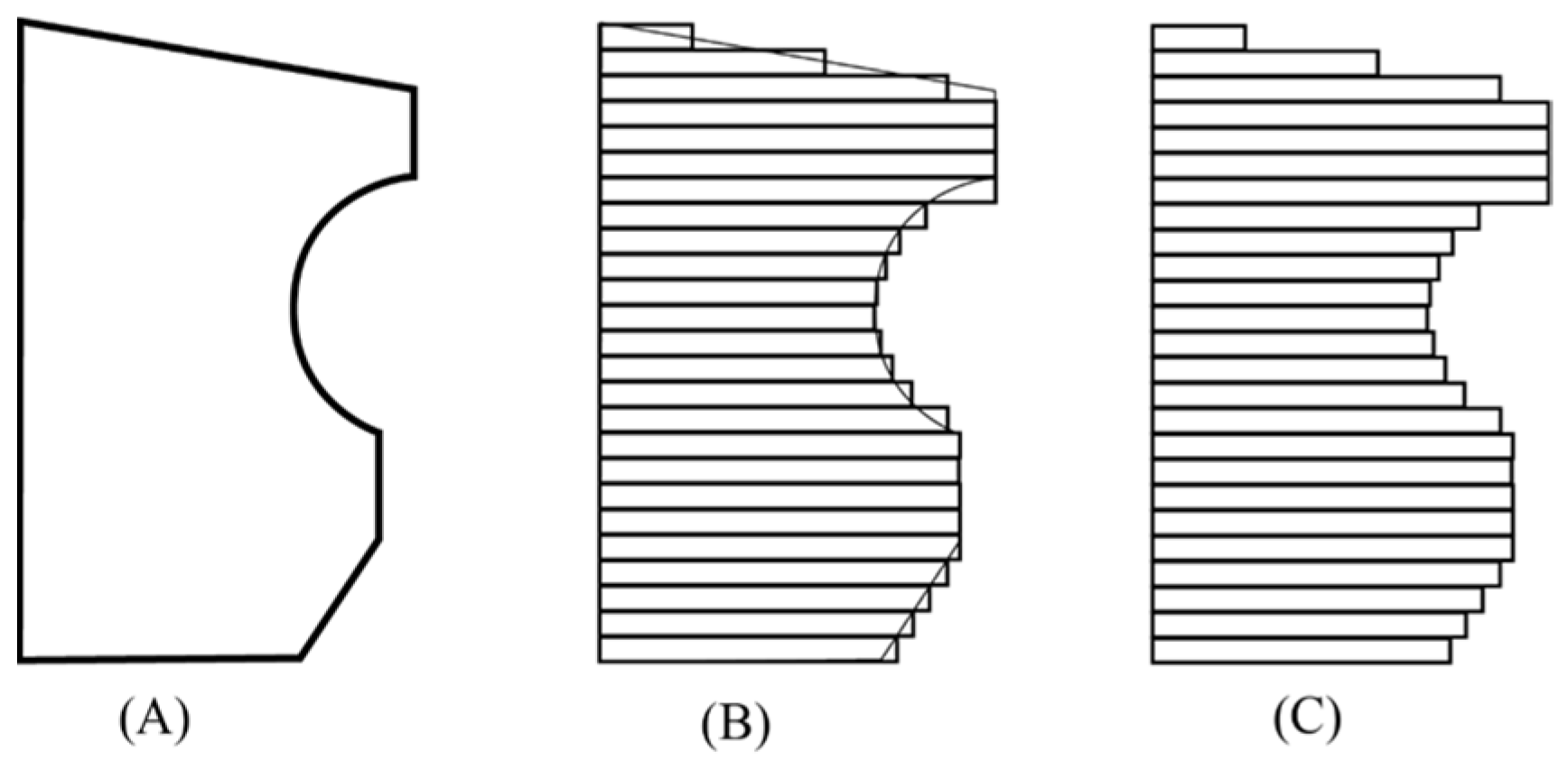
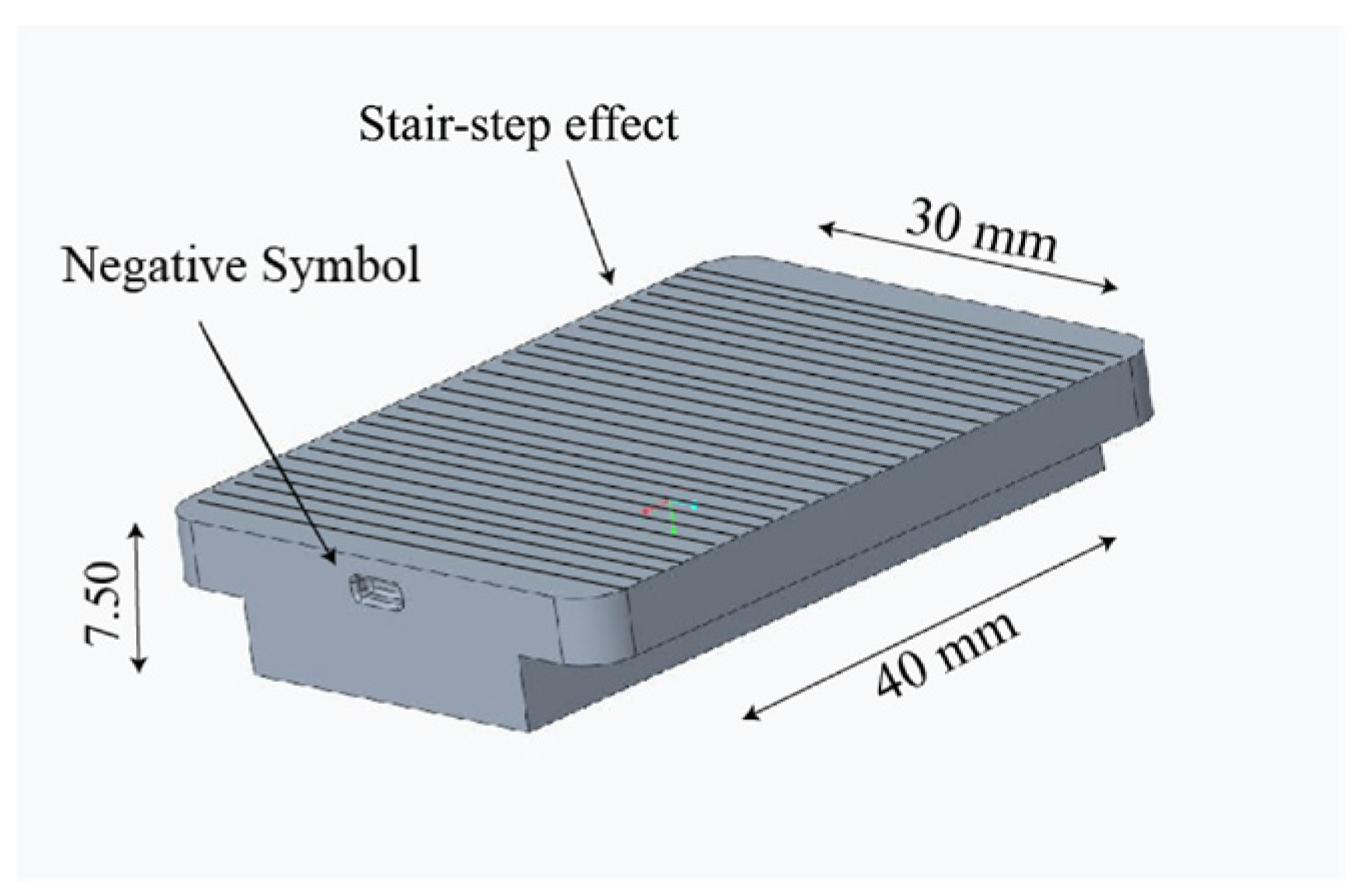



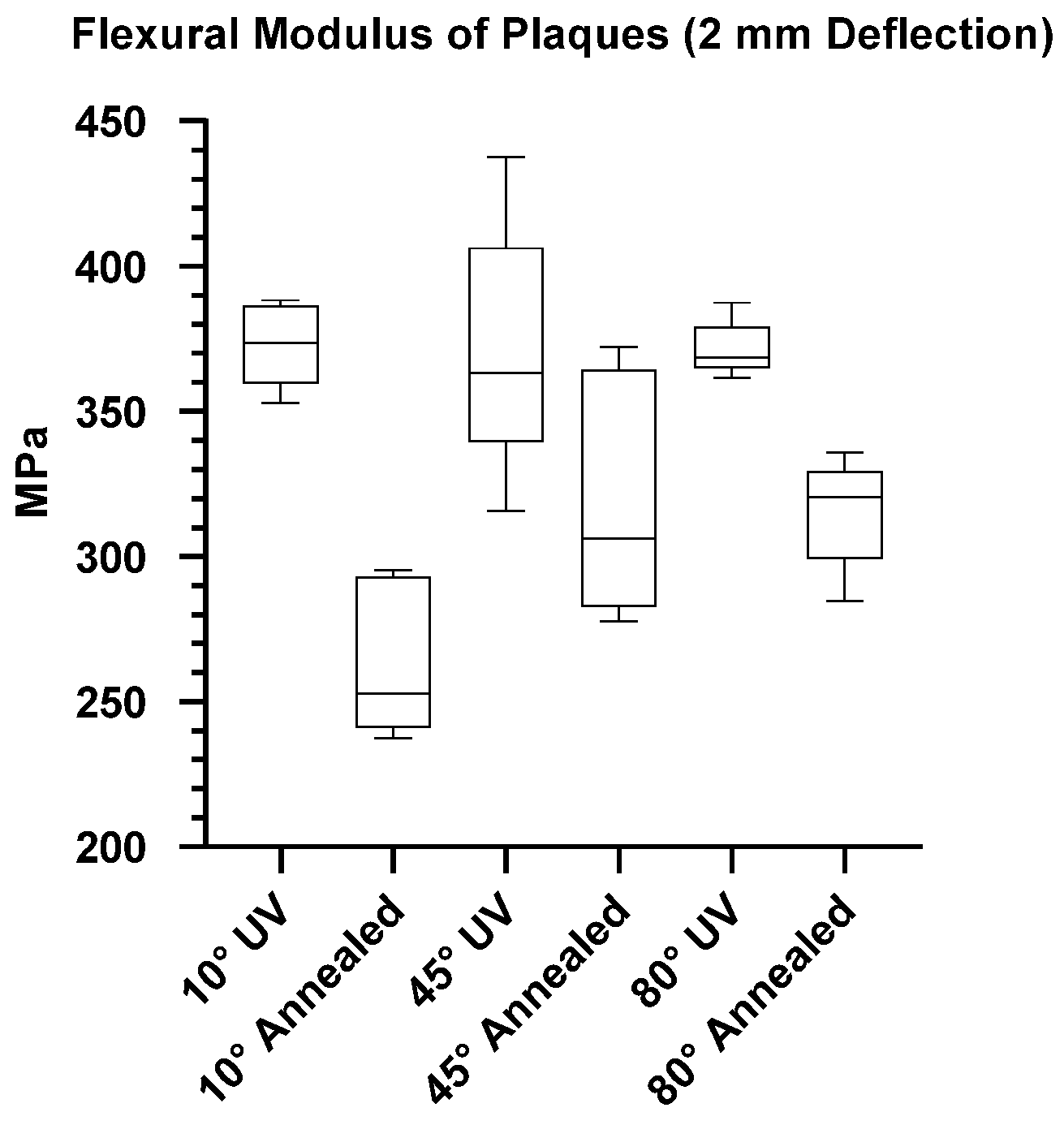



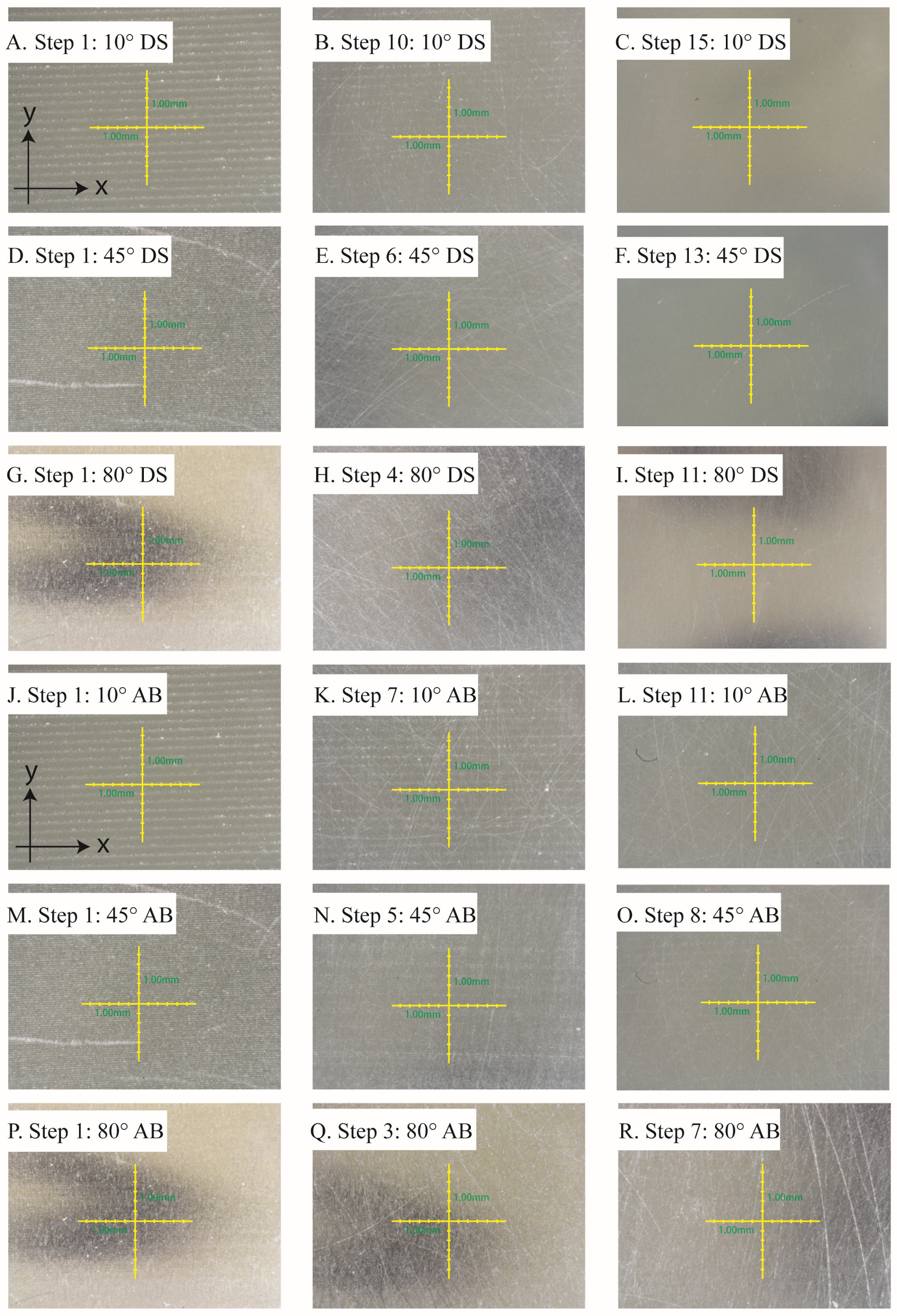

| Bench Marks | Finish | Target RA Range | Description/Application | ISO/TC 213 [32] | SPI [33] | VDI 3400 [34] |
|---|---|---|---|---|---|---|
| BM1 | High Polish | (0.1–0.14) μm | Shinny high gloss finish commonly used in automotive industry, generally used for aesthetical applications | N3 | A3 | No. 1–2 |
| BM2 | Texturised | (2.00–4.00) μm | Bead blasted finish generally used for functional applications to create grip | N7–N8 | D2–D3 | No. 26–32 |
| X (Ra μm) | Y (Ra μm) | Weight (g) | Dimensional Tolerance (mm) | |||||||||||
|---|---|---|---|---|---|---|---|---|---|---|---|---|---|---|
| Step | Grit | 10° | 45° | 80° | 10° | 45° | 80° | 10° | 45° | 80° | 10° | 45° | 80° | |
| A | 1 | NA * | 2.01 (S.D 0.36) | 3.42 (S.D 0.81) | 2.32 (S.D 0.10) | 10.51 (S.D 0.73) | 4.04 (S.D 0.54) | 1.89 (S.D 0.12) | 8.9076 (S.D 0.08) | 8.7633 (S.D 0.13) | 8.6617 (S.D 0.07) | 7.99 (S.D 0.22) | 7.74 (S.D 0.08) | 7.52 (S.D 0.01) |
| 2 | 180 | 1.91 (S.D 0.49) | 2.36 (S.D 0.29) | 1.97 (S.D 0.18) | 4.36 (S.D 1.00) | 2.51 (S.D 0.29) | 1.78 (S.D 0.06) | 8.8391 (S.D 0.10) | 8.6452 (S.D 0.14) | 8.6142 (S.D 0.05) | 7.94 (S.D 0.21) | 7.68 (S.D 0.08) | 7.48 (S.D 0.02) | |
| 3 | 180 | 1.87 (S.D 0.56) | 1.90 (S.D 0.21) | 1.70 (S.D 0.05) | 3.44 (S.D 2.40) | 1.89 (S.D 0.34) | 1.53 (S.D 0.18) | 8.7854 (S.D 0.11) | 8.5998 (S.D 0.14) | 8.5769 (S.D 0.05) | 7.89 (S.D 0.22) | 7.65 (S.D 0.07) | 7.47 (S.D 0.02) | |
| 4 | 240 | 1.53 (S.D 0.33) | 1.41 (S.D 0.20) | 1.36 (S.D 0.06) | 2.19 (S.D 1.07) | 1.52 (S.D 0.35) | 1.30 (S.D 0.12) | 8.7568 (S.D 0.10) | 8.5739 (S.D 0.14) | 8.5529 (S.D 0.05) | 7.87 (S.D 0.22) | 7.63 (S.D 0.07) | 7.46 (S.D 0.02) | |
| 5 | 240 | 1.40 (S.D 0.21) | 1.27 (S.D 0.16) | 1.26 (S.D 0.06) | 1.63 (S.D 0.48) | 1.19 (S.D 0.13) | 1.26 (S.D 0.03) | 8.7175 (S.D 0.09) | 8.5491 (S.D 0.14) | 8.5275 (S.D 0.05) | 7.85 (S.D 0.23) | 7.62 (S.D 0.06) | 7.45 (S.D 0.03) | |
| 6 | 280 | 1.22 (S.D 0.03) | 1.15 (S.D 0.09) | 1.14 (S.D 0.06) | 1.33 (S.D 0.07) | 1.13 (S.D 0.11) | 1.18 (S.D 0.03) | 8.6724 (S.D 0.09) | 8.5046 (S.D 0.14) | 8.4863 (S.D 0.04) | 7.83 (S.D 0.22) | 7.61 (S.D 0.06) | 7.43 (S.D 0.03) | |
| 7 | 280 | 1.19 (S.D 0.14) | 1.15 (S.D 0.09) | 1.07 (S.D 0.07) | 1.17 (S.D 0.01) | 1.09 (S.D 0.08) | 1.16 (S.D 0.11) | 8.6222 (S.D 0.10) | 8.4654 (S.D 0.14) | 8.4435 (S.D 0.04) | 7.81 (S.D 0.21) | 7.59 (S.D 0.06) | 7.42 (S.D 0.03) | |
| 8 | 320 | 1.18 (S.D 0.12) | 1.11 (S.D 0.07) | 1.04 (S.D 0.06) | 1.11 (S.D 0.09) | 1.07 (S.D 0.07) | 1.09 (S.D 0.06) | 8.5728 (S.D 0.11) | 8.4350 (S.D 0.14) | 8.4091 (S.D 0.08) | 7.80 (S.D 0.21) | 7.58 (S.D 0.06) | 7.41 (S.D 0.03) | |
| 9 | 320 | 1.14 (S.D 0.12) | 1.08 (S.D 0.04) | 1.03 (S.D 0.10) | 1.10 (S.D 0.05) | 1.01 (S.D 0.06) | 1.04 (S.D 0.11) | 8.5206 (S.D 0.11) | 8.3988 (S.D 0.14) | 8.3701 (S.D 0.08) | 7.78 (S.D 0.21) | 7.57 (S.D 0.06) | 7.40 (S.D 0.03) | |
| B | 10 | 400 | 0.85 (S.D 0.15) | 0.89 (S.D 0.14) | 0.91 (S.D 0.09) | 0.86 ((S.D 0.11) | 0.84 (S.D 0.16) | 0.83 (S.D 0.12) | 8.4817 (S.D 0.12) | 8.3726 (S.D 0.13) | 8.3421 (S.D 0.08) | 7.77 (S.D 0.21) | 7.56 (S.D 0.07) | 7.39 (S.D 0.02) |
| 11 | 600 | 0.46 (S.D 0.04) | 0.52 (S.D 0.12) | 0.49 (S.D 0.05) | 0.42 (S.D 0.06) | 0.45 (S.D 0.09) | 0.43 (S.D 0.05) | 8.4509 (S.D 0.12) | 8.3513 (S.D 0.13) | 8.3191 (S.D 0.08) | 7.76 (S.D 0.21) | 7.55 (S.D 0.06) | 7.38 (S.D 0.02) | |
| 12 | 1000 | 0.31 (S.D 0.04) | 0.34 (S.D 0.06) | 0.34 (S.D 0.02) | 0.31 (S.D 0.02) | 0.33 (S.D 0.06) | 0.31 (S.D 0.01) | 8.4259 (S.D 0.12) | 8.3360 (S.D 0.12) | 8.3034 (S.D 0.08) | 7.75 (S.D 0.20) | 7.54 (S.D 0.06) | 7.37 (S.D 0.03) | |
| 13 | 1500 | 0.20 (S.D 0.03) | 0.20 (S.D 0.02) | 0.21 (S.D 0.03) | 0.18 (S.D 0.02) | 0.20 (S.D 0.02) | 0.20 (S.D 0.02) | 8.4137 (S.D 0.12) | 8.3192 (S.D 0.13) | 8.2893 (S.D 0.08) | 7.74 (S.D 0.21) | 7.54 (S.D 0.06) | 7.37 (S.D 0.03) | |
| 14 | 2000 | 0.17 (S.D 0.02) | 0.17 (S.D 0.02) | 0.16 (S.D 0.01) | 0.17 (S.D 0.02) | 0.17 (S.D 0.02) | 0.15 (S.D 0.02) | 8.4049 (S.D 0.12) | 8.3080 (S.D 0.13) | 8.2788 (S.D 0.07) | 7.73 (S.D 0.21) | 7.53 (S.D 0.07) | 7.36 (S.D 0.03) | |
| 15 | 2500 | 0.12 (S.D 0.02) | 0.12 (S.D 0.02) | 0.12 (S.D 0.01) | 0.11 (S.D 0.01) | 0.12 (S.D 0.01) | 0.11 (S.D 0.02) | 8.4009 (S.D 0.12) | 8.3022 (S.D 0.13) | 8.2733 (S.D 0.07) | 7.73 (S.D 0.21) | 7.53 (S.D 0.07) | 7.35 (S.D 0.02) | |
| Time (Minutes) | X (Ra μm) | Y (Ra μm) | Weight (g) | Dimensional Tolerance (mm) | ||||||||
|---|---|---|---|---|---|---|---|---|---|---|---|---|
| 10° | 45° | 80° | 10° | 45° | 80° | 10° | 45° | 80° | 10° | 45° | 80° | |
| NA * | 2.97 (S.D 0.37) | 3.80 (S.D 0.29) | 2.97 (S.D 0.63) | 10.35 (S.D 0.49) | 4.10 (S.D 0.68) | 2.22 (S.D 0.43) | 9.0155 (S.D 0.04) | 8.7931 (S.D 0.05) | 8.7299 (S.D 0.05) | 7.94 (S.D 0.01) | 7.69 (S.D 0.05) | 7.57 (S.D 0.03) |
| 1 | 2.88 (S.D 0.30) | 3.92 (S.D 0.43) | 2.84 (S.D 0.23) | 6.31 (S.D 0.13) | 3.89 (S.D 0.53) | 2.24 (S.D 0.17) | 9.0141 (S.D 0.04) | 8.7918 (S.D 0.05) | 8.7284 (S.D 0.05) | 7.94 (S.D 0.01) | 7.69 (S.D 0.05) | 7.57 (S.D 0.03) |
| 2 | 2.85 (S.D 0.31) | 4.16 (S.D 0.92) | 2.86 (S.D 0.24) | 5.45 (S.D 0.72) | 3.76 (S.D 0.50) | 2.26 (S.D 0.17) | 9.0128 (S.D 0.05) | 8.7909 (S.D 0.05) | 8.7269 (S.D 0.05) | 7.93 (S.D 0.02) | 7.69 (S.D 0.05) | 7.56 (S.D 0.03) |
| 3 | 2.82 (S.D 0.27) | 3.57 (S.D 0.48) | 2.90 (S.D 0.23) | 4.75 (S.D 0.92) | 3.59 (S.D 0.46) | 2.27 (S.D 0.24) | 9.0113 (S.D 0.05) | 8.7898 (S.D 0.05) | 8.7254 (S.D 0.05) | 7.93 (S.D 0.02) | 7.68 (S.D 0.04) | 7.56 (S.D 0.02) |
| 4 | 2.89 (S.D 0.11) | 3.47 (S.D 0.47) | 2.91 (S.D 0.30) | 4.26 (S.D 0.77) | 3.55 (S.D 0.35) | 2.54 (S.D 0.25) | 9.0099 (S.D 0.05) | 8.7885 (S.D 0.05) | 8.7241 (S.D 0.05) | 7.93 (S.D 0.02) | 7.68 (S.D 0.05) | 7.56 (S.D 0.03) |
| 5 | 2.62 (S.D 0.29) | 3.57 (S.D 0.35) | 2.96 (S.D 0.21) | 3.84 (S.D 0.64) | 3.49 (S.D 0.41) | 2.53 (S.D 0.36) | 9.0087 (S.D 0.05) | 8.7873 (S.D 0.05) | 8.7227 (S.D 0.05) | 7.92 (S.D 0.02) | 7.67 (S.D 0.05) | 7.55 (S.D 0.03) |
| 6 | 2.70 (S.D 0.33) | 3.14 (S.D 0.36) | 2.92 (S.D 0.19) | 3.58 (S.D 0.31) | 3.06 (S.D 0.48) | 2.45 (S.D 0.15) | 9.0072 (S.D 0.05) | 8.7859 (S.D 0.05) | 8.7218 (S.D 0.05) | 7.92 (S.D 0.02) | 7.67 (S.D 0.05) | 7.55 (S.D 0.03) |
| 7 | 2.79 (S.D 0.35) | 3.40 (S.D 0.47) | 2.87 (S.D 0.22) | 3.35 (S.D 0.36) | 3.30 (S.D 0.50) | 2.52 (S.D 0.22) | 9.0061 (S.D 0.05) | 8.7846 (S.D 0.05) | 8.7214 (S.D 0.05) | 7.92 (S.D 0.02) | 7.67 (S.D 0.05) | 7.55 (S.D 0.03) |
| 8 | 2.73 (S.D 0.37) | 3.42 (S.D 0.38) | 2.80 (S.D 0.13) | 3.12 (S.D 0.22) | 3.12 (S.D 0.52) | 2.52 (S.D 0.10) | 9.0049 (S.D 0.05) | 8.7834 (S.D 0.05) | 8.7199 (S.D 0.05) | 7.91 (S.D 0.02) | 7.67 (S.D 0.05) | 7.55 (S.D 0.03) |
| 9 | 2.68 (S.D 0.32) | 3.22 (S.D 0.37) | 2.75 (S.D 0.16) | 2.88 (S.D 0.21) | 2.98 (S.D 0.44) | 2.46 (S.D 0.16) | 9.0040 (S.D 0.05) | 8.7826 (S.D 0.05) | 8.7190 (S.D 0.05) | 7.91 (S.D 0.02) | 7.66 (S.D 0.05) | 7.54 (S.D 0.03) |
| 10 | 2.42 (S.D 0.40) | 3.21 (S.D 0.37) | 2.60 (S.D 0.19) | 2.69 (S.D 0.07) | 2.87 (S.D 0.23) | 2.39 (S.D 0.13) | 9.0029 (S.D 0.05) | 8.7817 (S.D 0.05) | 8.7183 (S.D 0.05) | 7.91 (S.D 0.02) | 7.66 (S.D 0.05) | 7.54 (S.D 0.03) |
| Weight Reduction | Dimensional Difference (mm) | |||||
|---|---|---|---|---|---|---|
| Orientations | AB | DS | WS | AB | DS | WS |
| 10° | 0.14% | 5.69% | 7.80% | 0.03 | 0.21 | 0.32 |
| 45° | 0.13% | 5.26% | 6.90% | 0.03 | 0.17 | 0.24 |
| 80° | 0.13% | 4.48% | 6.50% | 0.03 | 0.11 | 0.20 |
Disclaimer/Publisher’s Note: The statements, opinions and data contained in all publications are solely those of the individual author(s) and contributor(s) and not of MDPI and/or the editor(s). MDPI and/or the editor(s) disclaim responsibility for any injury to people or property resulting from any ideas, methods, instructions or products referred to in the content. |
© 2024 by the authors. Licensee MDPI, Basel, Switzerland. This article is an open access article distributed under the terms and conditions of the Creative Commons Attribution (CC BY) license (https://creativecommons.org/licenses/by/4.0/).
Share and Cite
Keane, G.; Healy, A.V.; Devine, D.M. Post-Process Considerations for Photopolymer 3D-Printed Injection Moulded Insert Tooling Applications. J. Compos. Sci. 2024, 8, 151. https://doi.org/10.3390/jcs8040151
Keane G, Healy AV, Devine DM. Post-Process Considerations for Photopolymer 3D-Printed Injection Moulded Insert Tooling Applications. Journal of Composites Science. 2024; 8(4):151. https://doi.org/10.3390/jcs8040151
Chicago/Turabian StyleKeane, Gavin, Andrew V. Healy, and Declan M. Devine. 2024. "Post-Process Considerations for Photopolymer 3D-Printed Injection Moulded Insert Tooling Applications" Journal of Composites Science 8, no. 4: 151. https://doi.org/10.3390/jcs8040151
APA StyleKeane, G., Healy, A. V., & Devine, D. M. (2024). Post-Process Considerations for Photopolymer 3D-Printed Injection Moulded Insert Tooling Applications. Journal of Composites Science, 8(4), 151. https://doi.org/10.3390/jcs8040151






